Karna
The sage who gave Kunti the powerful mantra was Sage Durvasa. He is known in Hindu mythology for his short temper and the many curses he has given, but also for rewarding those who could satisfy him with their hospitality and dedication. When Kunti was a young girl, she served Durvasa with great devotion when he visited her uncle’s palace. Pleased with her service and seeing her virtuous nature, Durvasa bestowed upon her a special mantra. This mantra had the power to invoke any god, and by doing so, she could have a child by that deity.

Indra became Arjuna’s father through a similar divine intervention, facilitated by Kunti using the same mantra given to her by Sage Durvasa. After marrying Pandu, the king of Hastinapur, Kunti used this mantra to help her husband, who was cursed to die if he ever engaged in sexual intercourse. Unable to bear children naturally, Pandu asked Kunti to use her divine mantra to have children with gods, thus ensuring that his lineage would continue. Kunti also invoked the Wind God, Vayu, to birth Bhima, and later called upon Indra, the king of the gods, to have Arjuna. Indra, being the god of the heavens, thunder, rain, and war, was chosen to beget a son who would be a mighty warrior and a key figure in the Mahabharata.
As a part of his birth, Karna received an extraordinary gift from his father, Surya—an indestructible armor and earrings embedded into his body, making him nearly invincible in battle. This armor was not just a piece of protective gear but a symbol of divine protection and heritage, highlighting Karna’s celestial lineage.
Karna was a great warrior but he had a tough start in life because he was born to a princess (Kunti) who wasn’t married then. So, Karna was set afloat on a river by his mother and was later found and raised by a chariot driver and his wife.
Karna was raised by a charioteer, not knowing his royal origins. Despite his unmatched skills as a warrior, he was often rejected by the royal community because of his supposed low birth. This feeling of rejection shaped much of Karna’s life, driving him to prove his worth and seek acceptance among the elites.
Karna’s loyalty to his friend Duryodhana is another significant part of his story. Duryodhana, recognizing Karna’s talents and perhaps his need for acceptance, made him a king. This act of kindness won Karna’s undying loyalty, making him stand by Duryodhana through all the latter’s plots and battles against the Pandavas, who were actually Karna’s own brothers—a fact Karna discovered only later in life.
Karna’s generosity was tested when Indra, disguised as a Brahmin, asked for Karna’s divine armor and earrings. Knowing that giving them away would make him vulnerable in battle, Karna nevertheless removed them, literally cutting off the divine protection embedded in his skin, and handed them to Indra. This act is celebrated as one of the highest forms of charity and self-sacrifice.
Despite his virtues, Karna’s life was filled with sorrow and challenges. He faced curses that would later affect his fate in the battle of Kurukshetra.
- One such curse was from his teacher Parashurama, who cursed him after discovering that Karna had lied about his background to learn warfare. Parashurama’s curse was that Karna would forget the skills he had taught him at the moment of his greatest need.
- Another curse was pronounced on Karna by a Brahmin. Karna, practicing his archery, accidentally killed a cow that belonged to a Brahmin. The Brahmin, devastated by the loss of his cow, cursed Karna that he would be killed in the same way he had taken the life of the innocent animal. This meant that Karna would be defenseless and helpless in his moment of death, much like the cow was.
- The third significant curse came from the Earth Goddess. During a battle, Karna tried to invoke a divine weapon but was unable to lift his chariot wheel from the earth. In his frustration, Karna cursed the Earth. The Earth Goddess, angered by this disrespect, cursed him that when his life depended on it, he would be unable to lift his chariot wheel out of the earth. This curse manifested during his final confrontation with Arjuna, where he struggled to free his chariot wheel, making him vulnerable.
These curses, each tied deeply to pivotal moments of Karna’s life, highlight the tragic nature of his story—despite his nobility and generosity, his fate was sealed by these curses, leading to his downfall and death.
Karna was such a formidable warrior that his presence on the battlefield could have dramatically changed the outcome of the Mahabharata. It required a combination of three curses, the theft of his armor, and other extraordinary interventions to ensure his downfall.
Now coming back to Devraj Indra, the King of all Gods.
Indra, despite being a prominent deity in Hindu mythology and the king of gods, has notably fewer temples dedicated to him compared to other Hindu deities. Why?
Indra is often depicted riding an elephant named Airavata.
This elephant is not just any animal but a mythological white elephant with four tusks known for its immense strength and divine abilities. According to mythology, Airavata emerged during the churning of the ocean (Samudra Manthan) and was claimed by Indra as his mount.
The Story of Vritra
The story of Vritra’s defeat by Indra is discussed primarily in the Rigveda, which is the oldest of the four Vedas in Hindu scriptures. The Rigveda comprises various hymns that praise deities and reflect spiritual ideas, rituals, and practices of ancient Vedic civilization.
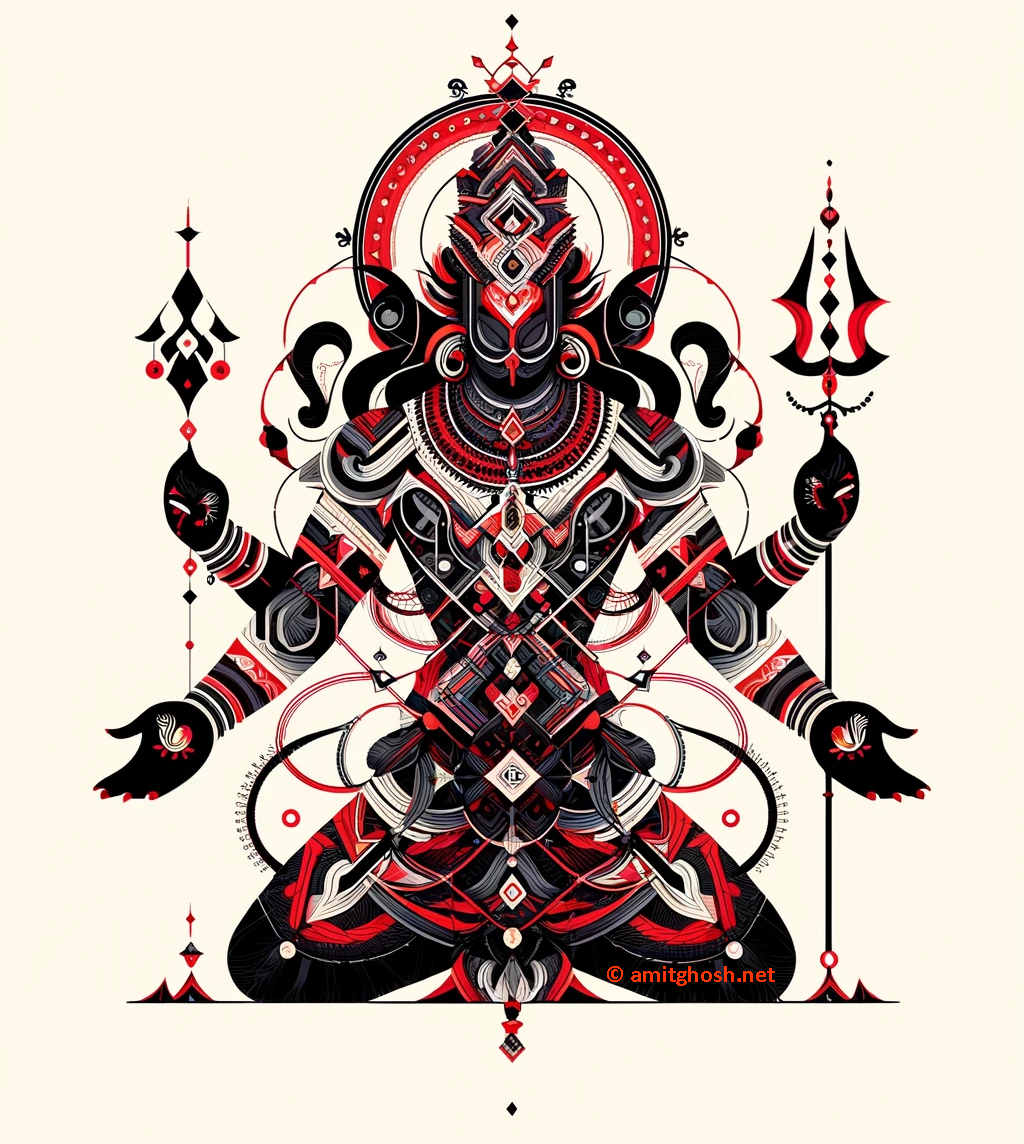
Vritra was created by the sage Tvashtr, who sought vengeance against Indra for killing his son, Vishvarupa. Vritra was given immense powers, enough to withhold all the waters of the world, causing a severe drought and suffering among the people and gods.
To release the waters and end the drought, Indra had to defeat Vritra. However, Vritra was granted a boon that he could not be killed by anything made of metal or any weapon made from wood or stone, and neither by anything dry or wet. This made Vritra nearly invincible.
Dadhichi was born to the sage Atharvan and his wife Chitti. He was a sage of great repute, known for his deep spiritual practices and mastery over the Vedas. Dadhichi’s ashram was located on the banks of the now-holy river Saraswati, where he taught and guided many disciples.
The divine architects, the Vishwakarma, revealed that only a weapon made from the bones of a sage could kill Vritra. Indra knew that such a request could only be fulfilled by a sage who possessed immense spiritual power and selflessness.
When Indra approached Dadhichi with the dire situation, the sage, without a moment’s hesitation, agreed to sacrifice his life for the greater good of the cosmos. Dadhichi saw this as an opportunity to perform the ultimate act of selflessness and service.
Tvashtr is no ordinary sage; he stands as the most powerful among the twelve Adityas. Among his siblings, Indra, the God of Thunder and King of Heaven, is his eldest brother. Tvashtr shines with a golden brilliance unique to him—his arms, his majestic chariot with its golden axle, and even his eyes, all glimmer like pure gold. This splendor, characterized by his radiant, golden hair, is reminiscent of Savitr, another deity associated with the sun’s nourishing rays.
Initially tasked with guiding souls to the afterlife, Tvashtr’s role evolved over time. In the sacred hymns of the Rig Veda, he is often mentioned alongside Surya, both sharing the same responsibilities. Soon along, His powers surpassed Indra as well. In the later verses, In the final book of the Rig Veda, some hymns explore the origins of the universe. The last verse of one such hymn names Savitr as Prajapati, “lord of created beings,” a title that later became associated with the principal god of the Brahmanas. He is the only solar God with this title. Surya and Not even Indra himself got this title.
He got the title of “Lord of the Womb”. His prowess and strength marked him as the chosen guardian of Soma, the divine nectar of immortality. Choosing a path of sage-like renunciation, he vowed never to wield his immense powers for personal gain, adopting the name Tvashtr.
He gave his responsibilities of guiding souls to his brother Pushan and gave the rest of the responsibilities to Surya. Nowadays, he not only bestowed immortality upon the gods but also ensured humans lived long, fulfilling lives.
Tvashtr’s influence extended to the Ribhus, skilled celestial artisans who crafted Indra’s horses, the Ashvins’ chariot, and the miraculous cow of Brihaspati. As the father of Brihaspati, Tvashtr granted the Ribhus eternal life recognized for their exceptional deeds.
However, as Vritra’s actions began to wreak havoc by withholding water and causing drought, Tvashtr regretted his decision. In a bid to rectify the imbalance his creation had caused, he played a crucial role in forging the Vajra, a divine thunderbolt. He agreed to forge the Vajra, the divine thunderbolt when Dadhichi meditated to transfer his spiritual energy out of his body and then relinquished his life so that his bones could be used to forge the Vajra.
Armed with Vajra, Indra faced Vritra in a fierce battle. The fight was colossal and shook the heavens and the earth. Finally, Indra was able to slay Vritra, releasing the waters and bringing relief to the world. The defeat of Vritra not only marked a significant victory for Indra but also reinstated him as a powerful protector of the cosmos and the divine order.
Once the gods saw how bravely Indra fought to release the waters, they chose him to be their king! Indra, now crowned as the king, unleashed the captured waters back to Earth through mighty rains and storms. From that day onwards, he was celebrated as the king of thunder and storms.
The slaying of Vritra, however, was not without its moral complexities. Vritra was a Brahmana because his great great grandfather was Lord Bhramha himself, and Indra’s act of killing him brought upon him the sin of Brahmahatya (the killing of a Brahmin). This led to Indra being shunned by the other gods and he had to undergo penance to cleanse himself of the sin.
The sacrifice of Dadhichi is celebrated in various texts and scriptures as an example of supreme sacrifice.
In post-Vedic literature, the deities Tvashtr and Savitr fade from prominence. Following these events, Savitr assumed the identity of Rishi Angiras. Renowned for his inherent wisdom, Angiras appears in several hymns of the Rigveda as one of the seven great sages, the Saptarishis, although in other verses he is noted without inclusion in this revered group. Angirasa focused his senses inward and meditated on Para Brahman, the creator of the creator. However, the texts provide little information on his fate following this period of meditation, leaving one to wonder if Savitr, ever the enigmatic force, transformed yet again, cloaking himself in a new mystery.
Heaven
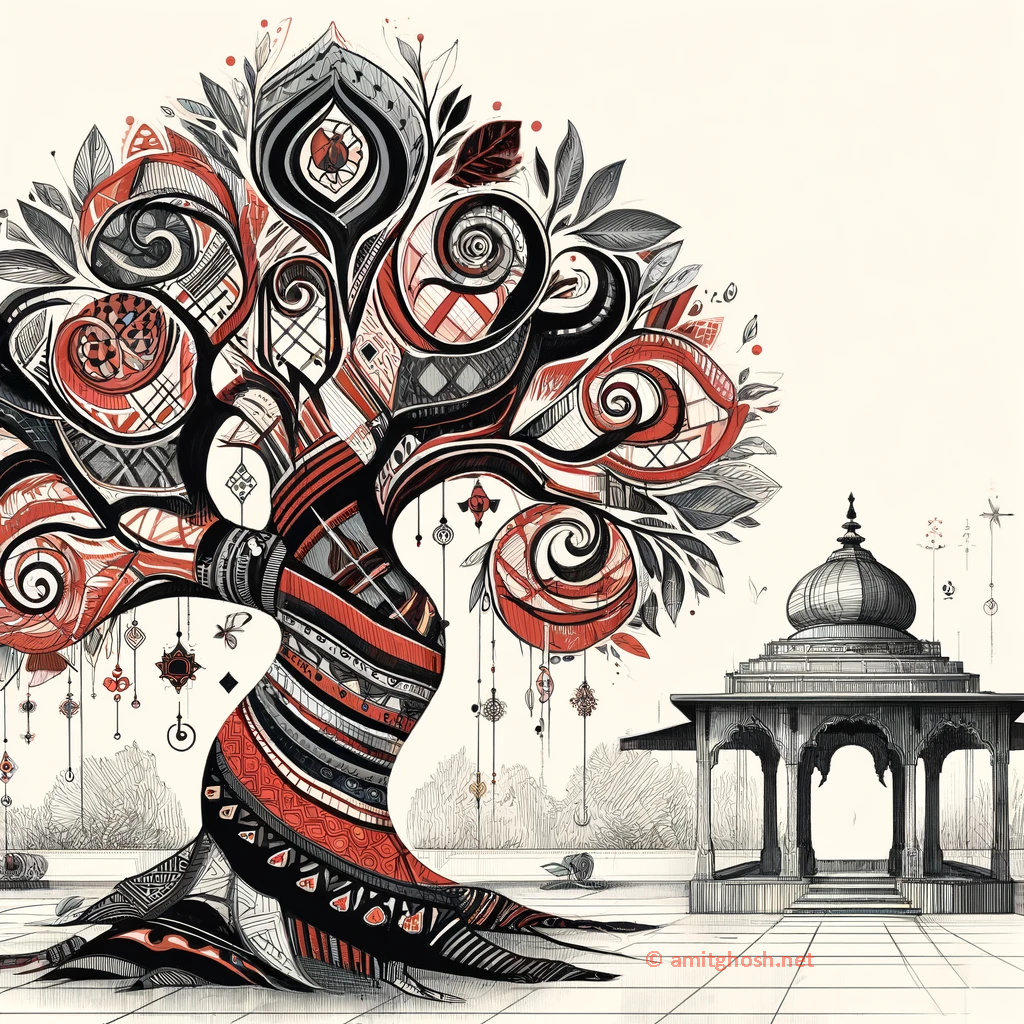
Sachi, also known as Indrani, is the wife of Indra and is revered as the queen of the gods. She is known for her beauty and is often depicted as a powerful goddess in her own right, associated with wrath and jealousy. Sachi supports Indra in his role as the king and is often involved in the heavenly affairs that shape the cosmos.
Nandankanan, sometimes referred to as Indra’s celestial garden, is said to house the Kalpavriksha, a wish-fulfilling tree. This tree is a significant element in Hindu mythology, symbolizing abundance and divine providence. It is believed to grant any wish to those who ask, reflecting the opulence and splendor of Indra’s heavenly kingdom.
Indra’s court is also famous for the Apsaras, celestial nymphs known for their beauty and artistic talents. These divine beings are often depicted as dancing and entertaining the gods. Indra, sometimes portrayed with a strong desire for pleasure, is associated with overseeing the Apsaras, which has led to tales of his indulgent and sometimes excessive nature when it comes to pleasures and entertainment.
The heavenly realm that Indra rules is often depicted as a place of immense beauty and wealth, equipped with divine treasures and luxuries. In contrast, the Asuras, often translated as demons or anti-gods, reside in a realm with fewer luxuries. This disparity is a root cause of the frequent conflicts between the gods and the Asuras, as the Asuras, envious of the celestial wealth, often attempt to invade heaven to claim its treasures and upset the divine order.
Indra’s battles with the Asuras are a recurring theme in the Vedas and other Hindu scriptures. While the general saying goes that “When Asuras and Devas battle, Devas always win,” the stories are more nuanced. Indra has indeed lost many wars.
Whenever Indra lost control of heaven, he often sought the assistance of the Trimurti—Brahma, Vishnu, and Shiva—who are considered the supreme deities in Hinduism. Their intervention typically helped Indra regain his throne, reinforcing the structure and order of the universe as dictated by the cosmic laws.
Indra’s constant fear of losing his crown is closely linked to a significant Vedic ritual known as the Ashvamedha Yagya. This grand ceremony not only had religious significance but also political implications, especially concerning the status and power of kingship.
Ashvamedha Yagya
The Ashvamedha Yagya, often referred to in ancient texts, was an elaborate royal ritual that ancient Indian kings undertook to assert their dominance and expand their influence. It involved the release of a royal horse, which would roam freely for a year, guarded by the king’s warriors. The territories through which the horse passed were challenged to either fight the king’s army or accept his sovereignty.
The ritual culminated with the horse being sacrificed in a grand ceremony attended by various dignitaries, priests, and sometimes other kings. The sacrifice was conducted with detailed Vedic chants and offerings to various deities, affirming the king’s right to rule and his relationship with the divine forces. The king who performed the Ashvamedha was believed to be blessed with prosperity, power, and an expansion of his realms.
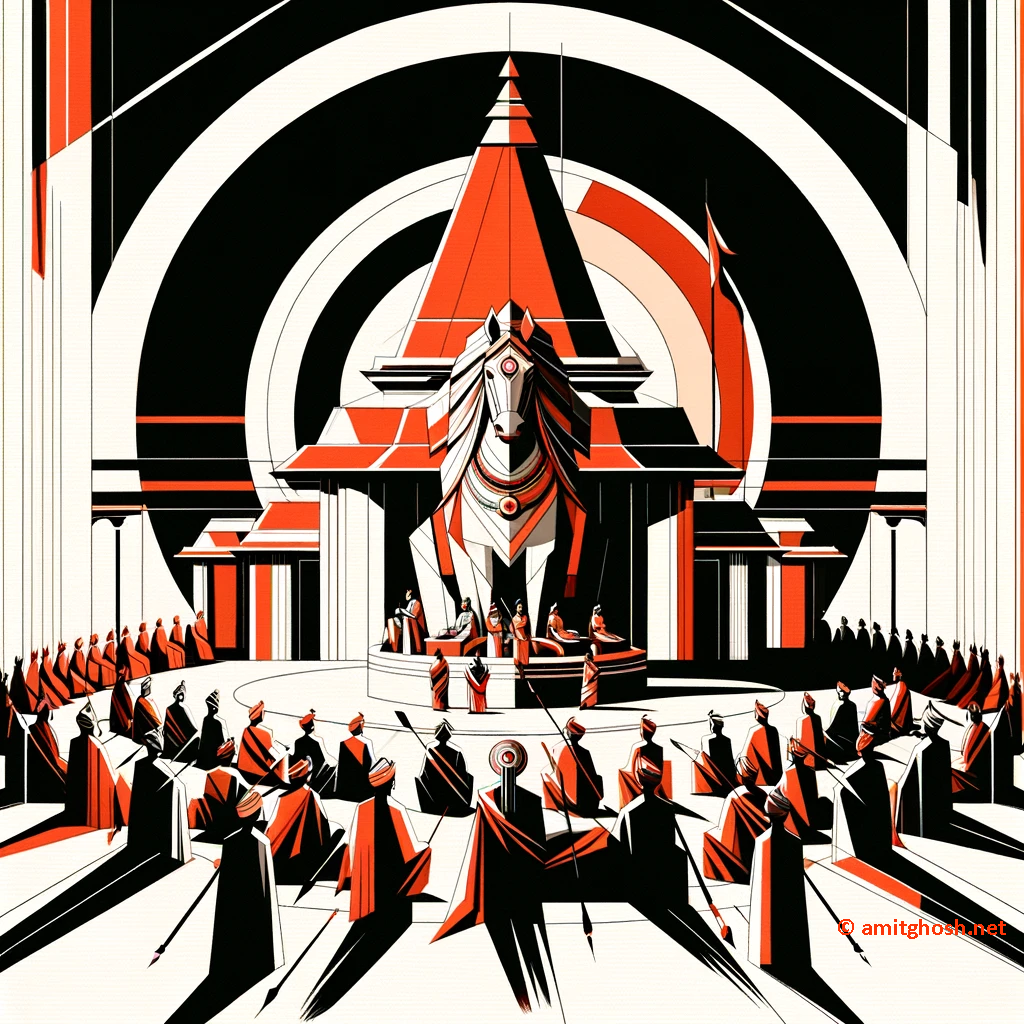
A significant aspect of this ritual was that any king or God who completed 1000 Ashvamedha Yagyas successfully would ascend to the status of Indra, the king of Gods.
As Indra’s fears about his crown grew stronger, his actions began to reflect a mix of insecurity and a growing sense of his own importance. He wanted to make sure that all the gods and even humans on Earth knew who was in charge.
Indra, being the god of rain and thunderstorms, made it clear that if anyone didn’t listen to him or tried to defy his authority, he could simply stop the rain from falling. This would mean no water for drinking, cooking, or growing crops, leading to drought and hard times for everyone.
This way of ruling through fear made many people and gods uneasy. They knew that without rain, life on Earth could become very difficult. Rivers would dry up, crops wouldn’t grow, and animals and people would start to go hungry. The thought of this happening made everyone very cautious about standing up to Indra or doing anything that might make him angry.
Biswamitra
Indra, the king of gods, was always very cautious about anyone who dedicated themselves to performing yagyas (ritual sacrifices) and meditation. He worried that these individuals might become so powerful from their spiritual practices that they could challenge his status or even take away his wealth and position if they received boons from the Trimurti, the three principal deities: Brahma, Vishnu, and Shiva.
To prevent this, Indra would often try to disrupt these spiritual practices. For example, he might send storms to extinguish the sacred fires of the yagyas or create other disturbances to break the concentration of those meditating.
Vishwamitra, originally a king named Kaushika, was known for his valiant and just rule. One day, while on a hunting expedition, Vishwamitra and his army stopped by the hermitage of Sage Vasishta. Vasishta welcomed them warmly and offered a feast, magically created by the divine cow Kamadhenu. Amazed by this cow’s power to grant any wish, Vishwamitra desired to possess it to benefit his kingdom. However, when Vasishta refused to part with Kamadhenu, Vishwamitra realized the power of spiritual prowess over kingly power and decided to become a sage himself, embarking on a journey of intense austerity.
Vishwamitra’s transformation was not easy. He undertook severe penances and meditation, striving to attain a higher spiritual status. His efforts, however, were continuously thwarted by Indra, who felt threatened by Vishwamitra’s potential rise in power. Indra feared that Vishwamitra, through his penance, could usurp his position as the king of gods.
To disrupt Vishwamitra’s meditation, Indra sent the celestial nymph Menaka to seduce him. Menaka succeeded in her mission, and the union between her and Vishwamitra resulted in the birth of a daughter, Shakuntala, who later became an important figure in the Indian epic narrative.

Despite this distraction, Vishwamitra returned to his spiritual practices, now with even more resolve. He faced many other challenges sent by Indra.
After many years of rigorous penance and overcoming numerous challenges, Vishwamitra finally accumulated enough spiritual power to ascend to the status of Brahmarishi, a title given to the highest order of sages, which Vasishta already held. This achievement was significant, as it marked his transformation from a royal king to a supreme sage, gaining powers that rivaled those of the gods.
It is notable that despite the provocations and challenges thrown his way by Indra, Vishwamitra ultimately does not retaliate against Indra.
Ahalya
In the past, Brahma—driven by curiosity—created several beautiful girls, among whom Ahalya was the finest, endowed with supreme virtues. Brahma pondered over who might be the most suitable guardian for this girl and considered Maharishi Gautama, who was distinguished by his exemplary virtues, sound judgment, and deep understanding of the Vedas. When Brahma entrusted Ahalya to Rishi Gautama, he instructed him to return her once she matured into a young woman.
Rishi Gautama cared for Ahalya, and upon her blossoming into a stunning young lady, he brought her back to Brahma. Astonished by the solemnity and greatness of Maharshi Gautama, Brahma decided that Ahalya should marry the sage. However, by this time, Ahalya’s divine beauty had already captivated all the Devas and Asuras. Additionally, she was blessed to forever retain the body and beauty of a 16-year-old…
Brahma declared that he would marry Ahalya to the person who could circumnavigate the Earth and return first. Upon hearing Brahma’s challenge, all the Devas and Rishis set off on their quest. Meanwhile, Maharshi Gautama, on his way back to his ashram, witnessed the birth of the divine cow, Kamdhenu. Struck by the significance of this moment and the power of creation, the sage, out of reverence, circumambulated the cow and a Shivling.
Brahma, utilizing his powers of meditation, became aware of everything. He explained to Rishi Gautama that circling the newly born cow, representative of the Earth with its seven islands, and the Shivling, symbolic of a journey around the Earth, fulfilled the challenge. Impressed by Gautama’s patience, wisdom, and devotion, Brahma decided that he was indeed worthy of marrying Ahalya.
After the marriage of Rishi Gautam and Ahalya, the other Devas and Rishis returned, burning with envy. Brahma then bestowed upon the couple the sacred land of Brahmgiri, a place renowned for granting wishes. Despite Lord Brahma having wed Ahalya to the virtuous sage Gautama, Indra, the king of the gods, continued to covet her…
Indra closely observed the daily routines of the sage and noted that each morning at dawn, the sage left his ashram. He would be away for a few hours, going to the river for his ritual bath and prayers. Unable to withstand the torments of love any longer, Indra resolved to win the woman of his desires through deceit. He persuaded the moon to transform into a rooster and crow much earlier than usual, to wake Gautama Rishi well before dawn.

Hearing the cock crow at 2 AM, the sage proceeded for his sacred bath. Seizing this opportunity, Indra descended to Earth disguised as Gautama Rishi and stealthily entered the hut. There, he boldly demanded Ahalya’s love. Ahalya, though the wife of a powerful yogi and endowed with spiritual insight, immediately recognized that the man before her was not her husband but the king of gods, Indra himself.
Nevertheless, Ahalya was flattered that such a prominent deity found her so alluring that he would risk the censure of the cosmos just to be with her. Smiling at him, she was too delighted to deny his bold request. Indra, capitalizing on the moment, wooed her further with eloquent compliments about her beauty. Swept away, she consented, and they succumbed to their passions. After this romantic entanglement, however, Ahalya regained her composure and promptly asked Indra to leave.
With his desires satisfied, Indra, now terrified of Sage Gautama’s anger, tried to hurry away. But just as he was leaving, Gautama came back, still wet from washing himself in the river. The sage looked at Indra and Ahalya and immediately knew what had happened. Anger quickly showed on his face, and he didn’t wait long to scold his wife, the moon, and Indra. That’s why the moon has spots—it got them as a punishment for helping in the trick.
Then Gautama turned his anger towards Ahalya. “Shame on you, Ahalya! You thought too highly of yourself, and it led you to make a big mistake. Now, you will lose the look you are so proud of and will only breathe air. You will be hidden from the world, no more important than a plain old rock, for many, many years. Only if Vishnu himself comes to this place will you be free again.”
He also faced Indra, who was still trying to sneak away. “Where do you think you’re going, shameless Lord?” the sage shouted. “Stop! I will give you exactly what you want the most. May your body, which made you so bold, be covered by what you desire, and also, may you lose the ability to use it.” After saying all this, Gautama left the ashram and went to live in the Himalayas.
Ahalya was transformed into a stone, and Indra suffered a severe punishment, becoming a eunuch with a thousand vaginas on his body.
Initially, Indra’s situation was ridiculed throughout the cosmos, but it soon became a tragic tale. He lived in darkness and isolation, unable to show himself to either men or women. This greatly troubled all the gods because Indra’s wide-ranging responsibilities across various worlds were left unattended, prompting them to collectively seek Brahma’s assistance.
Brahma advised Indra to undertake strict penance. By doing so, he won the favor of Shiva, who transformed the marks on his body into eyes. Henceforth, Indra was known as the thousand-eyed god.
Meanwhile, Ahalya spent years in deep remorse, subsisting only on air. True to the prophecy, she became invisible to the world, setting aside her renowned beauty and waiting for Vishnu’s arrival at the ashrama. Many years later, when Rama, Lakshmana, and Vishwamitra visited the hermitage, Ahalya regained her form when Rama touched her stoned idol. She then rejoined her husband in the Himalayas, and her story of redemption remains a celebrated example of penance and forgiveness.
In Hindu Tamil weddings in India and Sri Lanka, Ahalya is symbolically represented by a black grinding stone, which the bride touches with her foot as a vow not to emulate Ahalya. The bride is also shown the star associated with the chaste Arundhati, who is held up as an ideal. The Kama Sutra (301–600), a renowned treatise on sexual behavior, also references Ahalya and Indra, using their story to illustrate how lust can be destructive for men, yet paradoxically, it encourages men to woo women by recounting romantic tales like that of Ahalya.
In the Thai version of The Ramayana, called Ramakien, Vali and Sugriva are said to be Ahalya’s sons, born from her time with Indra and Surya. At first, everyone thought they were Sage Gautama’s sons because that’s what Ahalya told them. But later, Gautama’s daughter with Ahalya, named Anjani, told the truth about who their real fathers were. This made Gautama very upset, so he told the brothers they had to leave and even turned them into monkeys. Ahalya was so angry about this that she cursed Anjani, and because of the curse, Anjani had Hanuman, who is known as the monkey-god. This story changes a bit depending on which version you read.
The place where Ahalya did her deep thinking and made up for her mistakes is known as Ahalya Tirtha, and it’s a very special spot mentioned in old stories. But people aren’t sure exactly where it is. Some stories say it’s by the river Godavari and others say it’s by the river Narmada.
There’s also a temple called Ahilya Asthan in a place known as Ahalya’s village in the same area. This temple is all about Ahalya. If someone wants to be charming and attractive like the love-god Kamadeva, old texts like the Matsya Purana and the Kurma Purana say they should worship Ahalya at this temple. They should do this on a special day in the Hindu month of Chaitra, which is dedicated to Kamadeva. The stories say that if you take a bath at this sacred spot on that day, you’ll get to enjoy fun times with heavenly beauties.
Govardhan Puja
In the lush, vibrant lands of Vrindavan, where Lord Krishna spent his enchanting childhood, the day after Diwali is fervently celebrated as Annakuta or Govardhan Puja. Traditionally, this festival was dedicated to King Indra, the demigod of rain, whose blessings were deemed essential for a bountiful harvest. The Bhagavata Purana, a sacred text revered in these parts, narrates a pivotal event involving young Krishna that transformed this festival forever.
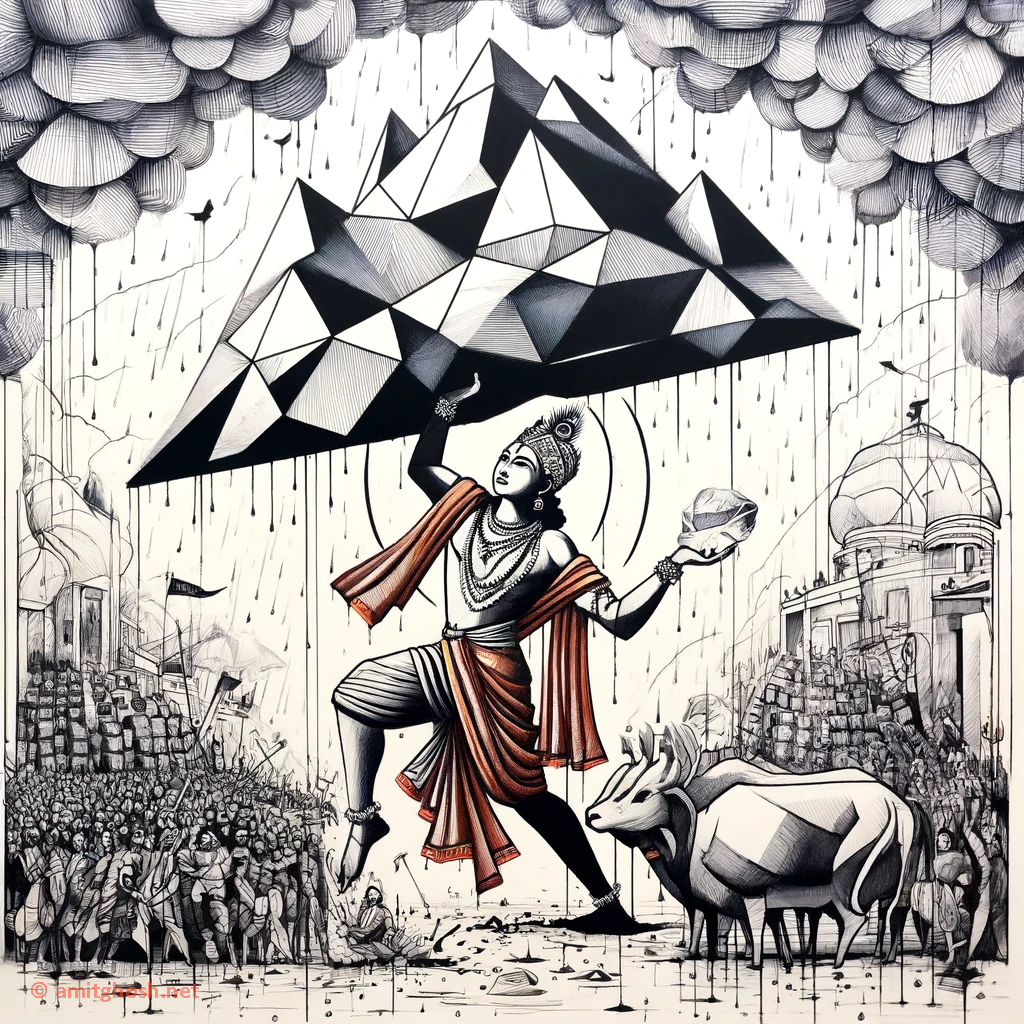
The story begins on a typical autumn day, when the villagers of Vrindavan, guided by age-old customs, prepared to honor Indra. However, Krishna, even as a young boy, possessed wisdom far beyond his years and a charismatic authority that resonated with the people of Gokul, a pastoral community within Vrindavan. He proposed a radical idea: instead of offering prayers to Indra, they should celebrate the Govardhan Hill, which directly nourished their cattle with its lush grass and, by extension, the villagers themselves through the cattle’s contributions of milk and plowing the fields. Krishna urged the people to see the hand of the divine not in the distant heavens controlled by Indra but in the immediate and tangible blessings of the earth they walked upon.
Krishna wanted the villagers to understand that the water cycle was a natural process and not solely under the control of deities like Indra. The water cycle, essential for life, begins with the evaporation of water from the surface of the earth, rising up into the atmosphere. There, the water vapor cools and condenses into clouds. When these clouds become heavy, they release their stored water as rain, which nourishes the earth, filling rivers and watering plants.
By urging the villagers to worship Govardhan Hill instead of Indra, Krishna sought to shift their focus from appeasing the deity of rain to acknowledging and respecting the natural processes that supported their agriculture.
The Bhagavata Purana, like many ancient texts, contains layers of wisdom that intertwine spiritual teachings with insights into natural phenomena. When Krishna challenges the traditional worship of Indra and redirects it towards honoring a natural formation like Govardhan Hill, it not only serves a spiritual purpose but also subtly educates about the environmental processes sustaining life, offering a scientific perspective on the world around us.
When Indra, the king of the gods, discovered that the villagers of Vrindavan were no longer worshiping him but were instead honoring Govardhan Hill, his pride was deeply hurt. Feeling ignored and undervalued, Indra decided to teach the villagers a lesson and assert his power. He gathered dark, menacing clouds over the usually peaceful Vrindavan, preparing to unleash a storm of epic proportions. Thunder clapped loudly, echoing across the land, and lightning flashed, turning the sky into a dramatic spectacle of nature’s fury. This was no ordinary storm—it was a deluge sent by a god, aimed to bring the villagers back to his fold through fear.
As the rain began to pour down heavily, turning the peaceful streams of Vrindavan into wild, churning torrents, the villagers’ lives and homes were at risk. Fields started to flood, threatening the crops that were vital for their survival. But Krishna, who was not just a mere boy but a being with divine powers, stood calm and composed amidst the chaos.
After observing seven days of continuous downpour and seeing how desperate and frightened his people were becoming, Krishna decided it was time to intervene. With a tranquility that seemed to spread over the area, he walked up to Govardhan Hill. In front of all the villagers, who watched in awe and disbelief, Krishna performed a miracle. He reached out with the little finger of his left hand and lifted the massive hill as easily as if it were a feather.
Krishna then held Govardhan Hill high above his head, turning it into a giant umbrella that sheltered the entire village from Indra’s relentless storm. Beneath this enormous stone canopy, the villagers, along with their cows and oxen, found a safe haven. They huddled together, finding comfort and warmth in Krishna’s protective presence. For seven days and nights, while the storm raged on outside this shelter, inside there was only calm and security.
As the week passed, the villagers witnessed the persistent wrath of Indra being effortlessly countered by the serene strength of Krishna. Indra’s efforts to bend the villagers to his will were futile against such divine protection. Eventually, the storm subsided, and Indra, witnessing the unwavering faith of the villagers in Krishna and the complete failure of his own attempts to intimidate them, felt his anger ebb away. Overcome with humility and a new understanding of his own limitations, Indra descended from the heavens and came to Vrindavan. There, in front of everyone, he bowed deeply before Krishna, acknowledging his supremacy and admitting the foolishness of his pride.
From that day, following the guidance of Lord Krishna, the people ceased their worship of Indra and began worshiping Mount Govardhan by preparing a giriyajna—a “great offering of foods and delicacies to the mountain.”
The day after Diwali, which was previously marked as a harvest festival in honor of King Indra, is now referred to as Annakuta, or Govardhan Puja. On this day, the inhabitants of Vrindavan now gather to celebrate and honor Mount Govardhan instead of King Indra.
Indrayatra
Indrayatra is one of the most vibrant and revered festivals celebrated in Kathmandu, Nepal. It centers on the story of Indra, the god-king of heaven in Hindu mythology, who comes to Earth disguised as a farmer. He descends in search of the parijat, also known as the night jasmine, a sacred white flower that his mother, Basundhara, needs for a ritual.
The story takes a dramatic turn at Maruhiti, a sunken water spout in the Maru area of Kathmandu, where Indra is busy plucking the flowers. Unaware of his divine identity, the local people mistake him for a common thief stealing the precious flowers.
They capture him and bind his hands, then display him publicly in the town square of Maru as a symbol of his capture. During Indrayatra, this scene is dramatically reenacted, with an effigy of Indra displayed bound in the square.
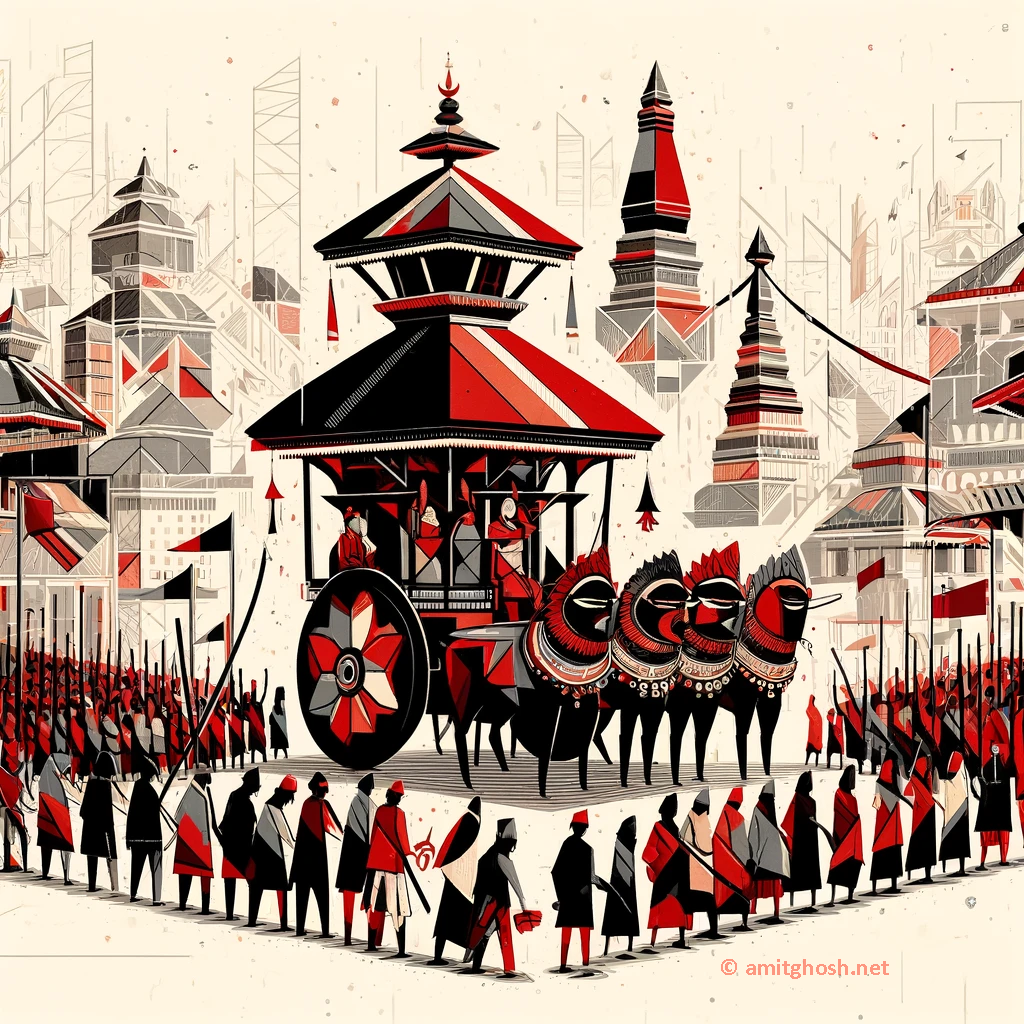
Swet Bhairav depicts the most dangerous and fierce face of Lord Shiva. His expression is so intimidating that, out of fear, locals keep it concealed behind a wooden frame window, typically revealing only one frame to devotees. The exception occurs during Indra Jatra, a special day when the full face is displayed.
While picking flowers nearby, Indra noticed Swet Bhairav meditating. True to his mischievous nature, Indra decided to disturb him. This provocation led Swet Bhairav to capture Indra, showcasing his fierce response to being disrupted during meditation. Indra’s divine powers are temporarily suspended or restrained while he is captured.
As the festival continues, the narrative shifts to his concerned mother, Basundhara, who, worried by her son’s extended absence, comes down to Earth. She searches frantically for Indra throughout Kathmandu. This part of the legend is commemorated by the procession of Dagin, which moves through the city. Meanwhile, the playful antics of Pulu Kisi, a wicker representation of an elephant, depict the frantic search of Aiarabat, Indra’s elephant for its master, adding a dynamic and entertaining element to the festivities.
When the people of Kathmandu realize that they have mistakenly captured the god-king Indra, they are struck with awe and quickly release him. In gratitude for his release, and to amend the mistake, Basundhara promises to provide enough dew during the winter months to ensure a rich crop. It is said that from the time of this festival, Kathmandu begins to experience foggy mornings, a divine gift resulting from Basundhara’s promise.
This is the story of King Indra, who not only faced the humiliation of being barred from worship, but was also captured by mere mortals. Bound with ropes, he found himself in a predicament that would usually befit only the most common of thieves. Shachi, the queen of the gods and goddess of wrath and jealousy, did not come to look for her husband, Indra, when he was captured by the mortals of Kathmandu. As the story unfolds, it is his mother, Basundhara, who takes the initiative to search for and negotiate the release of Indra.
Now the tale turns to Sachi, Indrani herself, and her reasons for not seeking out her husband during these tumultuous times. She was consumed by anger. The town that she had nurtured with her own hands, where stood the only temple dedicated solely to her in all the universe, had been destroyed. And all this ruin was a direct consequence of the actions of her husband, Indra. Her heart, once filled with compassion and benevolence for the earthly beings she cherished, now brimmed with betrayal and sorrow. Her creation, her connection to the mortal world, had been shattered not by external foes but by the one closest to her. This profound betrayal anchored her to a resolve of solitude and reflection, distancing herself from the events that unfolded thereafter.
Indrani Pargana
Sachi is often known as the queen of the gods – Indrani, being the consort of Indra, the king of heaven, and the god of rain and thunderstorms. She is one of the Sapta Matrikas—the seven mother goddesses—and is also the God of wrath and jealousy.
Indrani grew increasingly troubled by Indra’s frequent absences from Amaravati, the abode of the gods. Her heart filled with concern and loneliness each time Indra descended to Earth to ensure the proper distribution of rain and uphold the moral order. Despite her significant powers and responsibilities, Indrani desired more direct involvement in earthly affairs.

One day, while wandering through the ethereal gardens of Amaravati, Indrani stumbled upon a sacred grove where the Earth seemed to beckon her. Moved by a sudden impulse, she descended to the mortal world, disguised as a humble sage, to understand the lives of those her husband watched over.
As she traveled across the land, Indrani was moved by the plight of a drought-stricken village. The people prayed for rain, but there was none, as Indra was preoccupied with a celestial battle. Seeing their suffering, Indrani decided to intervene directly, revealing her divine nature. With a wave of her hand, she summoned clouds and rain, filling the rivers and rejuvenating the earth.
The villagers, grateful and awestruck, pledged their devotion to Indrani. In her honor, they built a grand temple and around it, a town grew, which they named Indrani Pargana. This place became a sanctuary where no drought could touch and where the villagers celebrated Indrani with a festival every year, marked by songs, dances, and offerings.
Seeing the prosperity and happiness of Indrani Pargana from his celestial throne, Indra realized the depth of Indrani’s compassion and wisdom. He visited Indrani Pargana in disguise to witness the devotion of its people. Touched by Indrani’s actions and the villagers’ faith, Indra decreed that Indrani Pargana would always be protected by the gods.
Indrani returned to Amaravati with a renewed sense of purpose and a connection to the earthly realm. She and Indra henceforth shared the responsibilities of the heavens and the earth, bringing them closer as they ruled over their domains.
Over centuries, Indrani Pargana flourished as a lush, verdant oasis at the confluence where the Ajay River merged with the mighty Ganga.
However, during the events of Govardhan, when Lord Krishna lifted the Govardhan hill to protect his people from the wrath of Indra, sentiments across many regions turned against the celestial deities. Indra’s actions were seen as tyrannical, leading to widespread discontent with the heavenly rulers.
In Indrani Pargana, the tide of faith began to turn as well. In a surge of anger and despair, they tore down the temple that was the heart of Indrani Pargana, renouncing their worship of Indrani and abandoning the town that had symbolized her care.
As the years passed, nature reclaimed the abandoned land. Thorns and wild growth enveloped the ruins of Indrani Pargana, as if to shield it from the world or perhaps to express the land’s own sense of betrayal. The town came to be known as Kantak Nagari, ‘the village of thorns’, a stark contrast to its former glory.
The transformation of Indrani Pargana into Kantak Nagari is a poignant development in this mythological tale, reflecting the changing relationships between the divine and the mortal realms. Here’s how the story could continue, blending the mythical elements with the geographical changes and the impact of human emotions.
Indra, the god of thunder, rain, and warfare, was once a major figure in ancient Vedic religion. In fact, a significant portion of the Vedas — about one-fourth — is dedicated to singing his praises. However, as time passed and new religious texts emerged, Indra’s role saw a big change.
In the earlier Vedic texts, Indra was a powerful deity who played a key role in many heroic battles and adventures. He was the god who controlled the weather and helped crops grow by bringing rain. People looked up to him as a strong and mighty figure.
In the stories of Ramayana and Mahabharata, we often see his jealous and ego-filled nature.
So when the Puranic texts were written, Indra’s image started to shift. These texts didn’t show him as the supreme god anymore. Instead, Indra became more of a guardian, watching over things but not being the main focus. This change in how Indra was seen — from a top god in the Vedic times to a sometimes jealous and less central figure in later stories — is one reason why there aren’t many temples dedicated to Indra today.



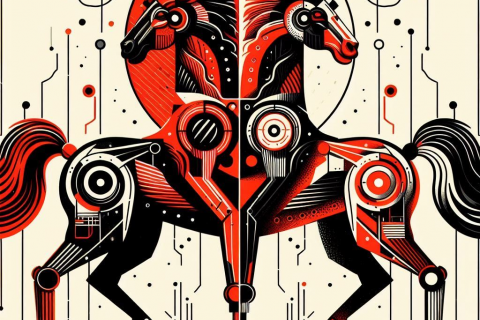










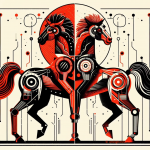
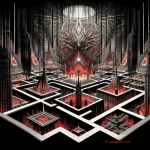
Leave a Reply